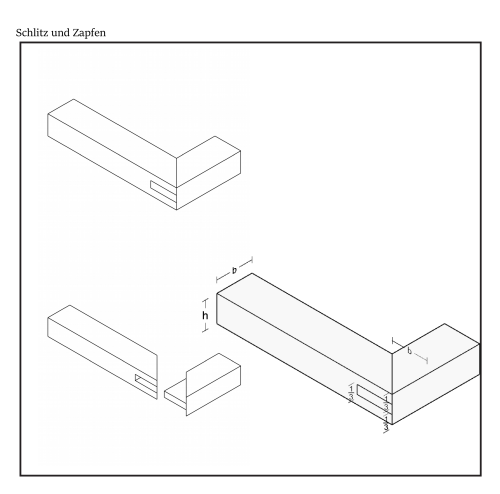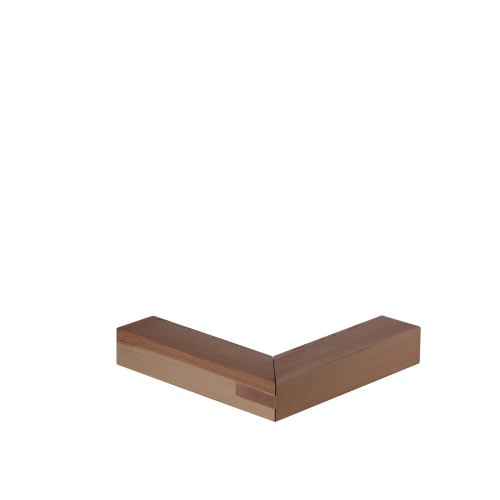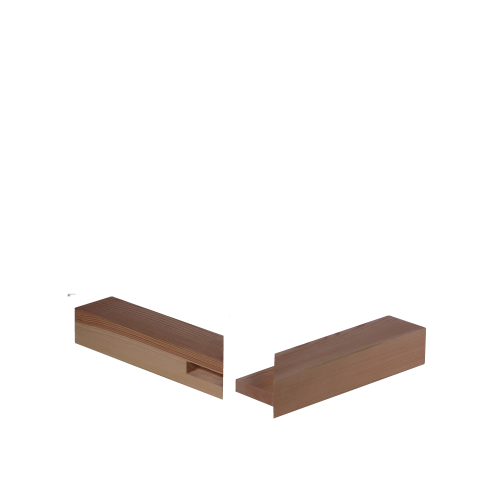mortise and tenon joint
Downloads
- Download 3DM File
- Download FactSheet File
The mitre tenon protects one side of the end grain with its geometric joint. The joint follows a simple rule of thirds of the wood width and a 45 degree angle. Since the joint is not secured by a wedge or a split pin, it is usually glued. It is more commonly used in furniture construction by joiners (e.g. when building a frame with infill. In glued form, pressure and shear loads can be transferred well (cf. Gerner, 1992, p. 64).
Mortise and tenon joints
Along with leaves, tenon joints are one of the oldest and most widespreada types of wood joint. The developmental stages of the tenon can hardly be traced, but it is certain that at the latest in 3000 BC wooden joints were made in the form of "insertion holes". Tenons for doors and gates were already known (cf. Gerner, 1992, p. 53). Due to the universal usability of tenons, they contribute decisively to constructive solutions and even make them possible. Thus, the mortise and tenon, a mortise and tenon that is secured with wedges or split pins, is considered the basis and most important element of all house frames and anchor beam constructions. For some constructions, the mortise and tenon joint is already considered the constructive basis at that time (cf. Gerner, 1992, p. 53).
Der Gehrungszapfen schützt eine Seite des Hirnholzes durch seine geometrische Verbindung. Die Verbindung folgt einer einfachen Drittel-Regel und einem 45-Grad-Winkel. Da die Verbindung nicht durch einen Keil oder einen Splint gesichert ist, wird sie in der Regel verleimt. Sie wird häufiger im Möbelbau von Tischlern verwendet (z. B. beim Bau eines Rahmens mit Füllung). In verleimter Form können Druck- und Scherbelastungen gut übertragen werden (vgl. Gerner, 1992, S. 64).
Die Zapfenverbindung ist neben dem Blatt eine der ältesten und am weitesten verbreiteten Holzverbindungsarten. Die Entwicklungsstufen des Zapfens lassen sich kaum nachvollziehen, aber es ist sicher, dass spätestens 3000 v. Chr. Holzverbindungen in Form von „Einstecklöchern“ hergestellt wurden. Zapfen für Türen und Tore waren bereits bekannt (vgl. Gerner, 1992, S. 53). Durch die universelle Verwendbarkeit von Zapfen tragen sie entscheidend zu konstruktiven Lösungen bei und machen diese sogar erst möglich. So gilt der Zapfen, ein mit Keilen oder Splinten gesicherter Zapfen, als Grundlage und wichtigstes Element aller Hausrahmen und Ankerbalkenkonstruktionen. Für einige Konstruktionen gilt die Zapfenverbindung schon damals als konstruktive Grundlage (vgl. Gerner, 1992, S. 53).
Übersetzt mit DeepL.com (kostenlose Version)




